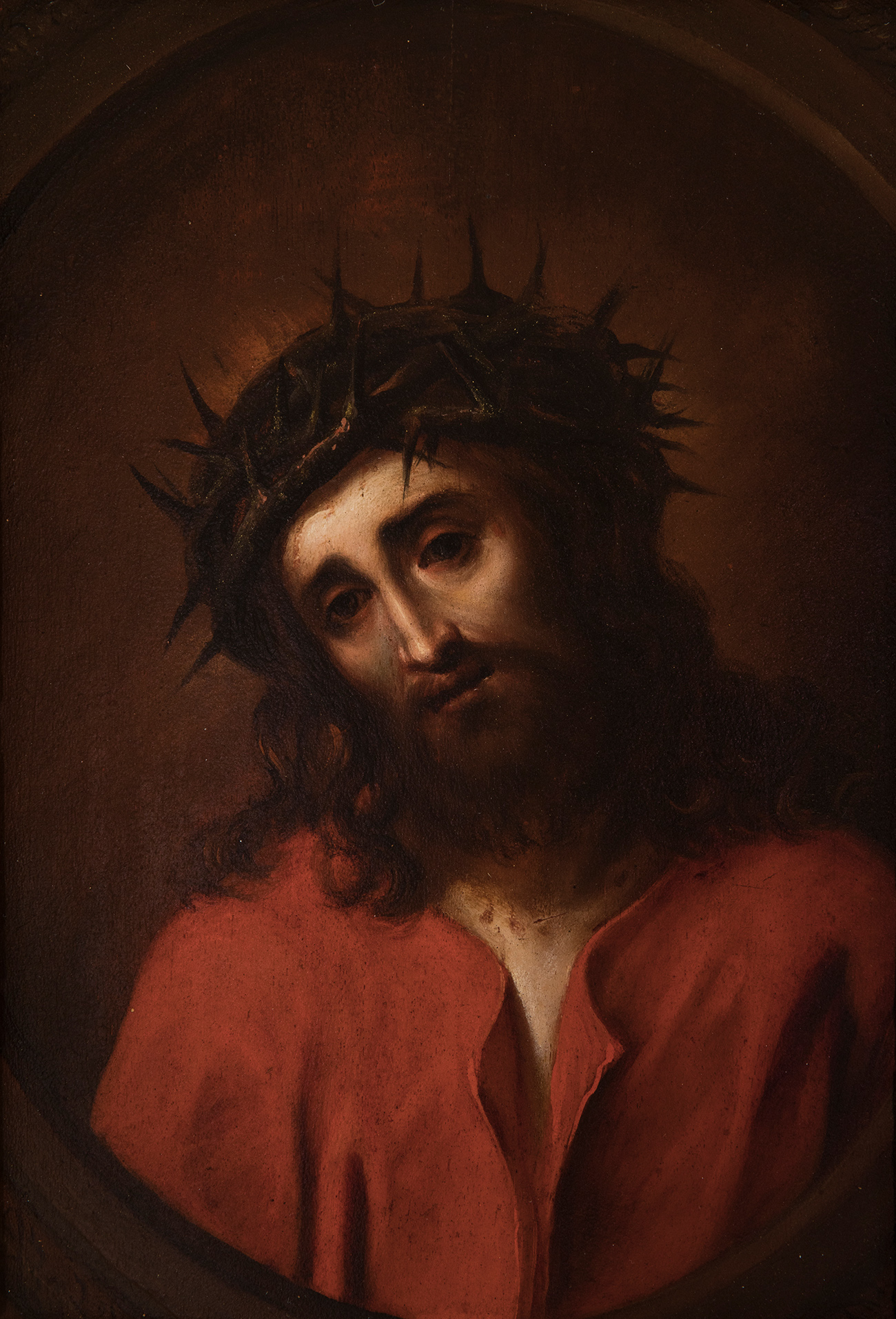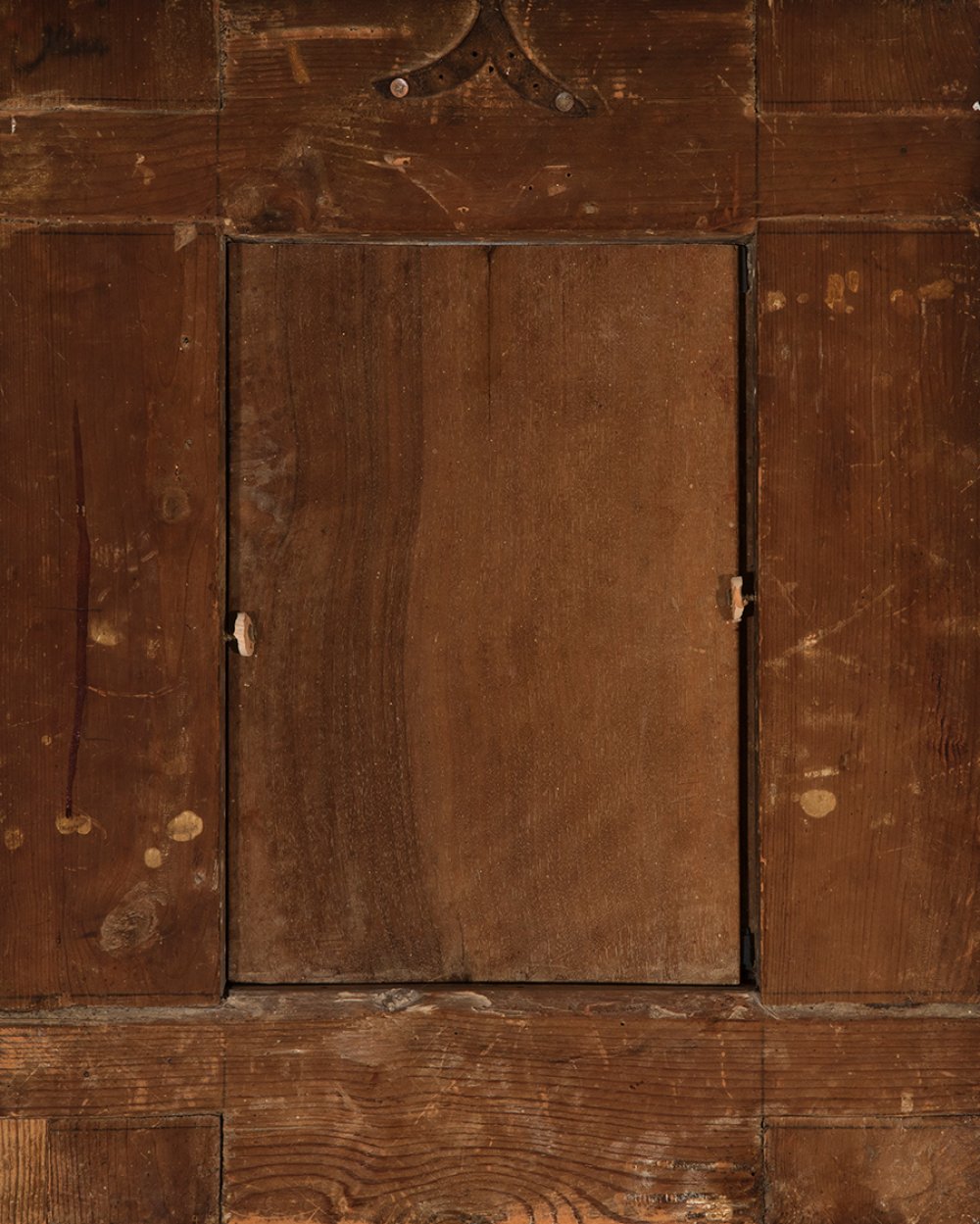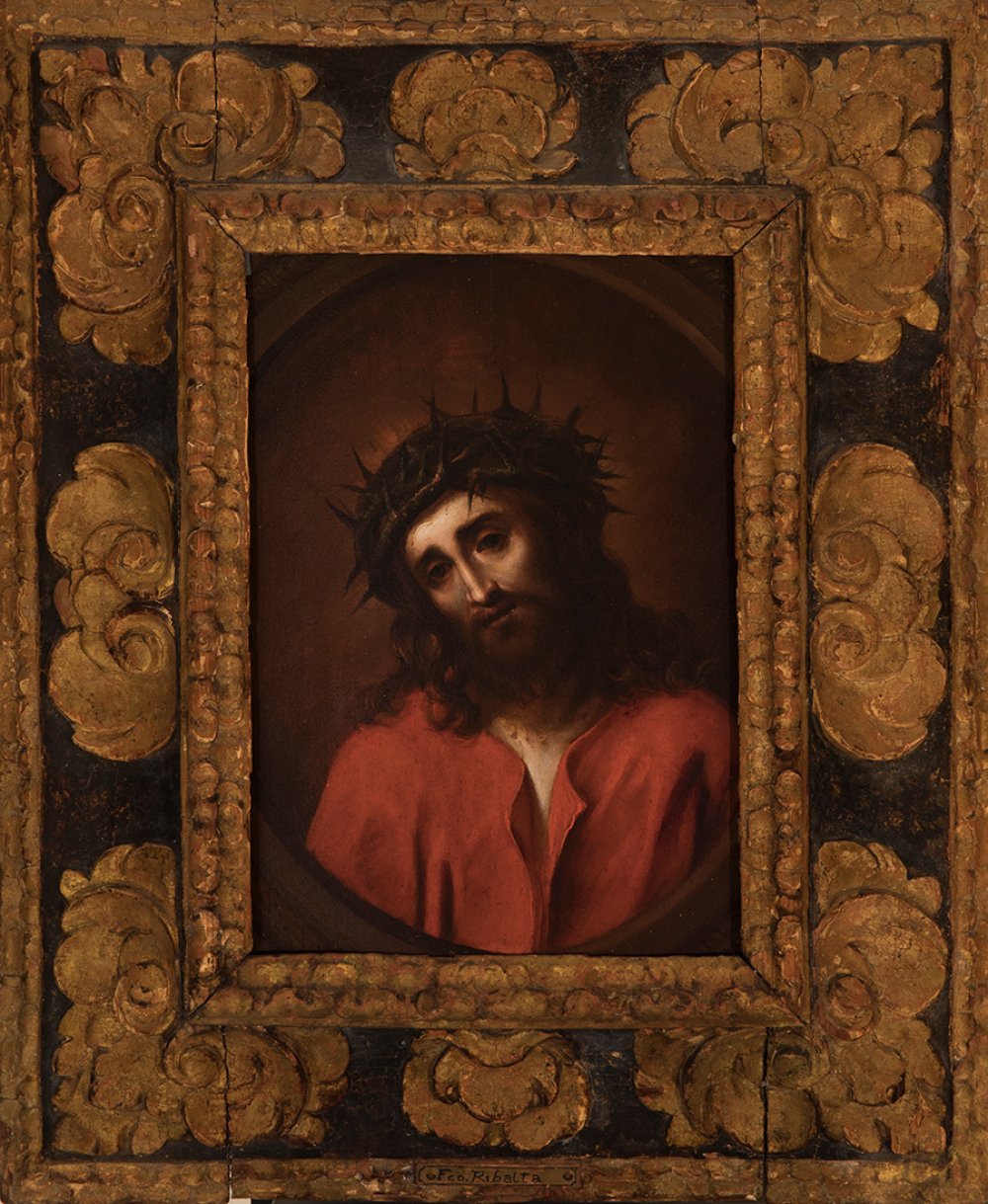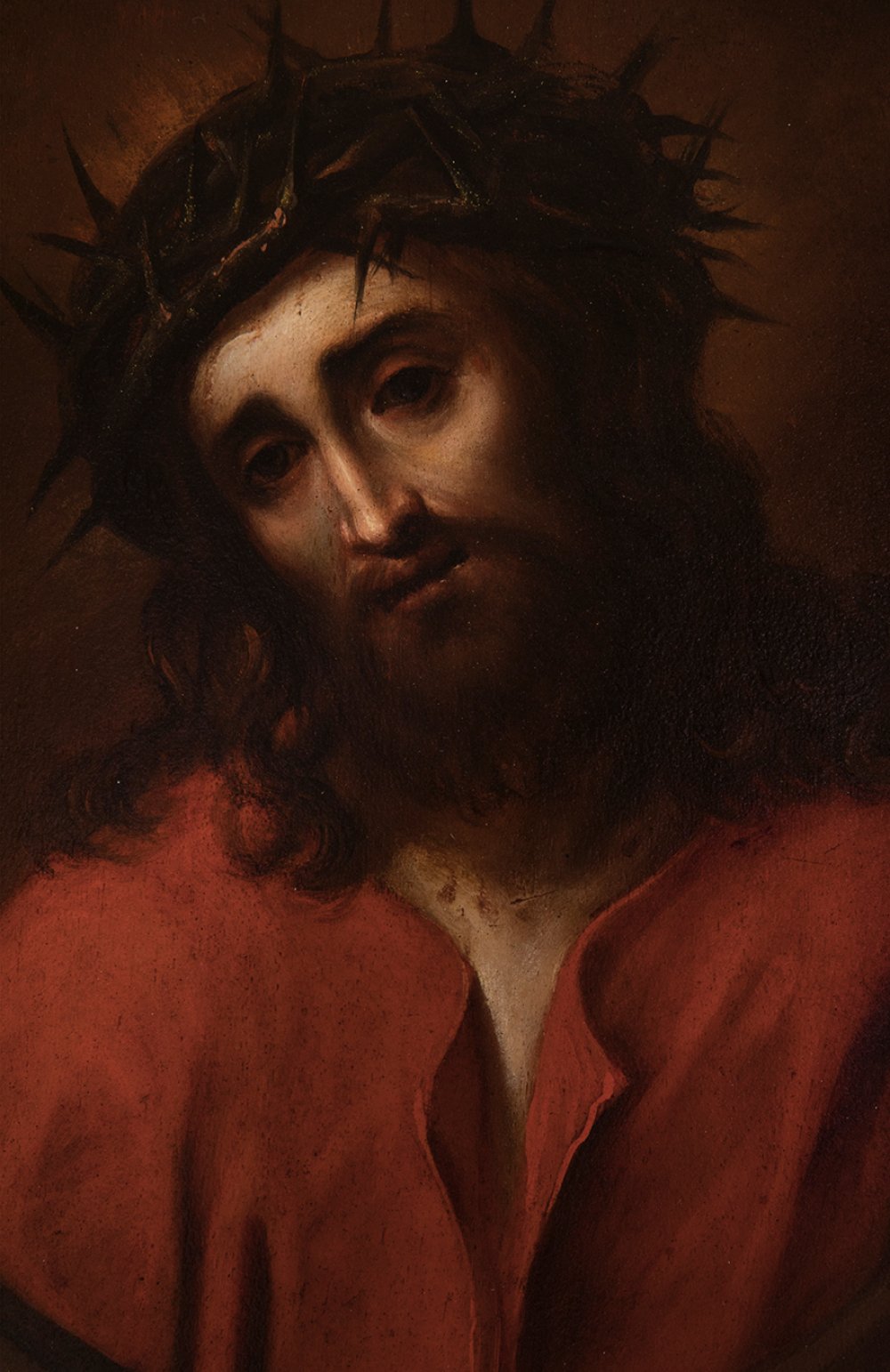51
Sevillian school; mid-17th century."Ecce Homo".Oil on panel.It has a Spanish frame of the period.
"Ecce Homo".
Oil on panel.
It has a Spanish frame of the period.
Measurements: 32 x 24 cm; 52,5 x 43 cm (frame).
In this devotional canvas, painted for an altar or private chapel, the theme of the Ecce Homo is represented, very common in this type of paintings. The simple, clear composition, with Christ's face in the foreground, the absence of narrative details enhances the expressive power and pathos, designed to move the soul of the faithful who pray before the image, within a sense of tremendism very typical of the Baroque period in Catholic countries. The theme of Ecce Homo belongs to the Passion cycle and precedes the episode of the Crucifixion. Following this iconography, Jesus is presented at the moment when the soldiers mock him, after crowning him with thorns, dressing him in a purple tunic (here red, the symbolic colour of the Passion) and placing a reed in his hand, kneeling down and exclaiming "Hail, King of the Jews". The words "Ecce Homo" are those pronounced by Pilate when presenting Christ to the crowd; their translation is "behold the man", a phrase by which he mocks Jesus and implies that Christ's power was not such in comparison with that of the rulers who were judging him. Formally, this work is dominated by the highly contrasted and dramatic treatment of light, based on a spotlight that falls directly on the figure of Christ.
The dramatism that stands out in the scene, reflected in the blood of the body that falls on Christ's body, contrasts with the austere and recollected attitude of the body's posture. It is this bodily composition that brings the artist closer to the work of Murillo. Considered by some to be the painter who best defines the Spanish Baroque, Bartolomé Esteban Murillo exerted a notable influence on his Sevillian contemporaries and, after his death, his influence can be found in other schools even to the present day, especially in religious art. In the 18th century his language and iconographic formulas were widely followed and repeated, and during the Romantic period numerous copies of his works were made. However, it was in the Baroque period of the 18th century that the importance of his influence, spread by his numerous disciples and followers, was most evident. In fact, in that century he was the best known and most appreciated Spanish painter outside Spain, the only one of whom Sandrart includes a biography in his "Academia picturae eruditae", a work dating from the end of the 17th century. In the last decades of the 17th century, Murillo's emotional, sweet and delicate sentimentality prevailed in Seville over the more dramatic one of Valdés Leal, hence the predominance of his influence in the following century. As time went on, however, we find an increasingly superficial influence, focused on the imitation of models and compositions, but leaving aside his plastic language in favour of formulas more typical of the new century.
"Ecce Homo".
Oil on panel.
It has a Spanish frame of the period.
Measurements: 32 x 24 cm; 52,5 x 43 cm (frame).
In this devotional canvas, painted for an altar or private chapel, the theme of the Ecce Homo is represented, very common in this type of paintings. The simple, clear composition, with Christ's face in the foreground, the absence of narrative details enhances the expressive power and pathos, designed to move the soul of the faithful who pray before the image, within a sense of tremendism very typical of the Baroque period in Catholic countries. The theme of Ecce Homo belongs to the Passion cycle and precedes the episode of the Crucifixion. Following this iconography, Jesus is presented at the moment when the soldiers mock him, after crowning him with thorns, dressing him in a purple tunic (here red, the symbolic colour of the Passion) and placing a reed in his hand, kneeling down and exclaiming "Hail, King of the Jews". The words "Ecce Homo" are those pronounced by Pilate when presenting Christ to the crowd; their translation is "behold the man", a phrase by which he mocks Jesus and implies that Christ's power was not such in comparison with that of the rulers who were judging him. Formally, this work is dominated by the highly contrasted and dramatic treatment of light, based on a spotlight that falls directly on the figure of Christ.
The dramatism that stands out in the scene, reflected in the blood of the body that falls on Christ's body, contrasts with the austere and recollected attitude of the body's posture. It is this bodily composition that brings the artist closer to the work of Murillo. Considered by some to be the painter who best defines the Spanish Baroque, Bartolomé Esteban Murillo exerted a notable influence on his Sevillian contemporaries and, after his death, his influence can be found in other schools even to the present day, especially in religious art. In the 18th century his language and iconographic formulas were widely followed and repeated, and during the Romantic period numerous copies of his works were made. However, it was in the Baroque period of the 18th century that the importance of his influence, spread by his numerous disciples and followers, was most evident. In fact, in that century he was the best known and most appreciated Spanish painter outside Spain, the only one of whom Sandrart includes a biography in his "Academia picturae eruditae", a work dating from the end of the 17th century. In the last decades of the 17th century, Murillo's emotional, sweet and delicate sentimentality prevailed in Seville over the more dramatic one of Valdés Leal, hence the predominance of his influence in the following century. As time went on, however, we find an increasingly superficial influence, focused on the imitation of models and compositions, but leaving aside his plastic language in favour of formulas more typical of the new century.
26th October - Old Masters
Sale Date(s)
Venue Address
General delivery information available from the auctioneer
Setdart offers Worldwide shipping
PICK UP IN ROOM: You can come and pick up your lots in our offices (Barcelona, Madrid or Valencia). At the moment of the withdrawal, you will be able to accept the current conditions of the lot by means of a document that you will sign.
YOU CAN SEND ANOTHER PERSON TO PICK UP: This person must present a signed authorization that you can find in our web page by accessing from BUY AT SETDART- LOGISTICS-DOWNLOAD AUTHORIZATION DOCUMENT. You can also send an e-mail with the requested data in AUTHORIZATION DOCUMENT to admin@setdart.com
Important Information
25% buyer´s premium
21% buyer´s premium at www.setdart.com
Terms & Conditions
The maximum period to pay the lots is 7 working days. You can pay either via bank transfer or with credit card through our platform www.setdart.com (we only accept VISA or Mastercard).
BUYER´S PREMIUM: 22% Hammer price + 21% VAT from the buyer´s premium
If your piece has more than 100 years, our Ministry of Culture requires an export certificate in order for the piece to leave the country. Note that if the piece goes inside the EU, there is no cost for the export certificate. If the piece goes outside the EU, there is a cost for the export certificate. You can find more information in our Ministry of Culture website: https://www.culturaydeporte.gob.es/en/cultura/patrimonio/exportacionimportacion/exportacion/tasas.html
INQUIRIES: admin@setdart.com
Setdart guides you through the entire process, from the time of award to the day you receive your lot. Our logistics team will be happy to manage your transport, and will advise you on the best shipping method with professionals from the sector used to handling works of art and jewelry.
WE OFFER WORLDWIDE DOOR TO DOOR SHIPPING
PICK UP IN ROOM: You can come and pick up your lots in our offices. At the moment of the withdrawal, you will be able to accept the current conditions of the lot by means of a document that you will sign.
YOU CAN SEND ANOTHER PERSON TO PICK UP: This person must present a signed authorization that you can find in our web page by accessing from BUY AT SETDART-LOGISTICS-DOWNLOAD AUTHORIZATION DOCUMENT. You can also send an e-mail with the requested data in AUTHORIZATION DOCUMENT to admin@setdart.com
SETDART IS NOT RESPONSIBLE FOR THE STATE OF THE PARTS ONCE THEY LEAVE OUR FACILITIES. MRW SHIPMENTS: Once the payment is made, your lot will be packed for shipment, the logistics department will send you an e-mail notifying you of the day it leaves our warehouse, changes of address cannot be made after receiving this e-mail.
INSURANCE INCIDENTS: Coverage for the value of the auction up to 3000 ? per shipment, if the value of the auction is higher, Setdart will send you a quote including the additional insurance. The insurance company WILL NOT BE RESPONSIBLE FOR THE SHIPMENT THAT EXCEEDS THAT AMOUNT AND IS NOT FULLY INSURED. MRW INCIDENTS: Maximum notification 48 hours after receipt, after which the insurance company WILL NOT BE RESPONSIBLE AND NO CLAIMS WILL BE ACCEPTED.
E-MAIL LOGISTICS: logistica@setdart.com
PICK UP YOUR MESSAGES: You can send your own messaging, prior notice via e-mail that your shipment is ready, please note 3 or 4 days in advance. This type of shipment is packaged so Setdart will provide you with a quote.
EXPENSES FOR STORAGE: We inform you that if the purchased lot is not picked up within a month, you will be charged 30€ per week per lot. Setdart Online S.L., owner of the web site "setdart.com", "setdart.net" and "setdart.org", acts as a company of Spanish nationality inscribed in the Volume 36955, sheet 182, page B-293056 of the Mercantile Registry, with registered office at Calle Aragó












